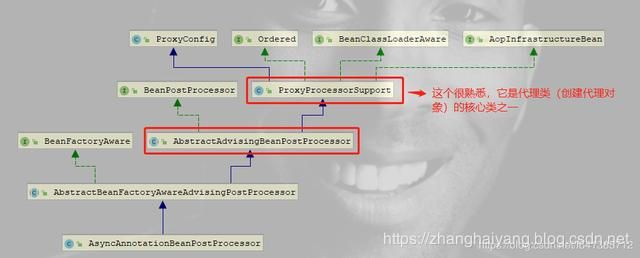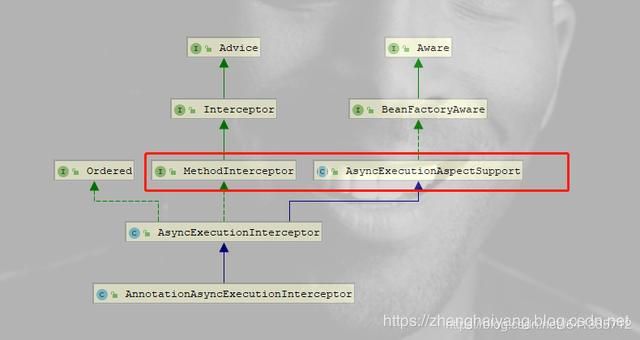Spring学习总结(29)——Spring异步处理@Async的使用以及原理、源码分析(@EnableAsync)
在开发过程中,我们会遇到很多使用线程池的业务场景,例如异步短信通知、异步记录操作日志。大多数使用线程池的场景,就是会将一些可以进行异步操作的业务放在线程池中去完成。例如在生成订单的时候给用户发送短信,生成订单的结果不应该被发送短信的成功与否所左右,也就是说生成订单这个主操作是不依赖于发送短信这个操作,所以我们就可以把发送短信这个操作置为异步操作。那么本文就是来看看Spring中提供的优雅的异步处理方案:在Spring3中,Spring中引入了一个新的注解@Async,这个注解让我们在使用Spring完成异步操作变得非常方便。需要注意的是这些功能都是Spring Framework提供的,而非SpringBoot。因此下文的讲解都是基于Spring Framework的工程。Spring中用@Async注解标记的方法,称为异步方法,它会在调用方的当前线程之外的独立的线程中执行,其实就相当于我们自己new Thread(()-> System.out.println("hello world !"))这样在另一个线程中去执行相应的业务逻辑。
Demo
// @Async 若把注解放在类上或者接口上,那么他所有的方法都会异步执行了~~~~(包括私有方法)
public interface HelloService {
Object hello();
}
@Service
public class HelloServiceImpl implements HelloService {
// 注意此处加上了此注解
@Async
@Override
public Object hello() {
System.out.println("当前线程:" + Thread.currentThread().getName());
return "service hello";
}
}然后只需要在配置里,开启对异步的支持即可:
// 开启异步注解的支持
@Configuration
@EnableAsync
public class RootConfig {
}输出如下(当前线程名):
当前线程:SimpleAsyncTaskExecutor-1
可以很明显的发现,它使用的是线程池SimpleAsyncTaskExecutor,这也是Spring默认给我们提供的线程池(其实它不是一个真正的线程池,后面会有讲述)。下面原理部分讲解后,你就能知道怎么让它使用我们自定义的线程池了~~~
@Async注解使用细节
- @Async注解一般用在方法上,如果用在类上,那么这个类所有的方法都是异步执行的;
- @Async可以放在任何方法上,哪怕你是private的(若是同类调用,请务必注意注解失效的情况~~~)
- 所使用的@Async注解方法的类对象应该是Spring容器管理的bean对象
- @Async可以放在接口处(或者接口方法上)。但是只有使用的是JDK的动态代理时才有效,CGLIB会失效。因此建议:统一写在实现类的方法上
- 需要注解@EnableAsync来开启异步注解的支持
- 若你希望得到异步调用的返回值,请你的返回值用Futrue变量包装起来
需要额外导入哪些Jar包?
它的依赖包非常简单,只依赖一些Spring的核心包外加spring-aop,但是如果你已经导入了spring-webmvc这个jar,那就什么不需要额外导入了,因为都有了:
备注:它虽然依赖于Spring AOP,但是它并不需要导入aspectjweaver,因为它和AspectJ没有半毛钱关系
原理、源码解析
@EnableAsync
它位于的包名为org.springframework.scheduling.annotation,jar名为:spring-context
@EnableXXX这种设计模式之前有分析过多次,这个注解就是它的入口,因此本文也一样,从入口处一层一层的剖析:
@Target(ElementType.TYPE)
@Retention(RetentionPolicy.RUNTIME)
@Documented
@Import(AsyncConfigurationSelector.class)
public @interface EnableAsync {
//默认情况下,要开启异步操作,要在相应的方法或者类上加上@Async注解或者EJB3.1规范下
@Asynchronous注解。
//这个属性使得开发人员可以自己设置开启异步操作的注解(可谓非常的人性化了,但是大多情况下用Spring的就足够了)
Class annotation() default Annotation.class;
// true表示启用CGLIB代理
boolean proxyTargetClass() default false;
// 代理方式:默认是PROXY 采用Spring的动态代理(含JDK动态代理和CGLIB)
// 若改为:AdviceMode.ASPECTJ表示使用AspectJ静态代理方式。
// 它能够解决同类内方法调用不走代理对象的问题,但是一般情况下都不建议这么去做,不要修改这个参数值
AdviceMode mode() default AdviceMode.PROXY;
// 直接定义:它的执行顺序(因为可能有多个@EnableXXX)
int order() default Ordered.LOWEST_PRECEDENCE;
}
@Target({ElementType.METHOD, ElementType.TYPE})
@Retention(RetentionPolicy.RUNTIME)
@Documented
public @interface Async {
// May be used to determine the target executor to be used when executing this method
// 意思是这个value值是用来指定执行器的(写入执行器BeanName即可采用特定的执行器去执行此方法)
String value() default "";
}最重要的,还是上面的@Import注解导入的类:AsyncConfigurationSelector
AsyncConfigurationSelector
public class AsyncConfigurationSelector extends AdviceModeImportSelector {
// 这类 我也不知道在哪?是用于支持AspectJ这种静态代理Mode的,忽略吧~~~~
private static final String ASYNC_EXECUTION_ASPECT_CONFIGURATION_CLASS_NAME =
"org.springframework.scheduling.aspectj.AspectJAsyncConfiguration";
@Override
@Nullable
public String[] selectImports(AdviceMode adviceMode) {
// 这里AdviceMode 进行不同的处理,从而向Spring容器注入了不同的Bean~~~
switch (adviceMode) {
// 大多数情况下都走这里,ProxyAsyncConfiguration会被注入到Bean容器里面~~~
case PROXY:
return new String[] { ProxyAsyncConfiguration.class.getName() };
case ASPECTJ:
return new String[] { ASYNC_EXECUTION_ASPECT_CONFIGURATION_CLASS_NAME };
default:
return null;
}
}
} AdviceModeImportSelector父类的这个抽象更加的重要。它的实现类至少有如下两个:
备注:TransactionManagementConfigurationSelector需要额外导入jar包:spring-tx
这个父类抽象得非常的好,它的作用:抽象实现支持了AdviceMode,并且支持通用的@EnableXXX模式。
//@since 3.1 它是一个`ImportSelector`
public abstract class AdviceModeImportSelector implements ImportSelector {
// 默认都叫mode
public static final String DEFAULT_ADVICE_MODE_ATTRIBUTE_NAME = "mode";
// 显然也允许子类覆盖此方法
protected String getAdviceModeAttributeName() {
return DEFAULT_ADVICE_MODE_ATTRIBUTE_NAME;
}
// importingClassMetadata:注解的信息
@Override
public final String[] selectImports(AnnotationMetadata importingClassMetadata) {
// 这里泛型,拿到泛型类型~~~
Class annType = GenericTypeResolver.resolveTypeArgument(getClass(), AdviceModeImportSelector.class);
Assert.state(annType != null, "Unresolvable type argument for AdviceModeImportSelector");
// 根据类型,拿到该类型的这个注解,然后转换为AnnotationAttributes
AnnotationAttributes attributes = AnnotationConfigUtils.attributesFor(importingClassMetadata, annType);
if (attributes == null) {
throw new IllegalArgumentException(String.format( "@%s is not present annType.getSimpleName(), importingClassMetadata.getClassName()));
}
// 拿到AdviceMode,最终交给子类,让她自己去实现 决定导入哪个Bean吧
AdviceMode adviceMode = attributes.getEnum(this.getAdviceModeAttributeName());
String[] imports = selectImports(adviceMode);
if (imports == null) {
throw new IllegalArgumentException(String.format("Unknown AdviceMode: '%s'", adviceMode));
}
return imports;
}
// 子类去实现 具体导入哪个Bean
@Nullable
protected abstract String[] selectImports(AdviceMode adviceMode);
}改抽象提供了支持AdviceMode的较为通用的实现,若我们自己想自定义,可以考虑实现此类。
由此可议看出,@EnableAsync最终是向容器内注入了ProxyAsyncConfiguration这个Bean。由名字可议看出,它是一个配置类。
ProxyAsyncConfiguration
// 它是一个配置类,角色为ROLE_INFRASTRUCTURE 框架自用的Bean类型
@Configuration
@Role(BeanDefinition.ROLE_INFRASTRUCTURE)
public class ProxyAsyncConfiguration extends AbstractAsyncConfiguration {
// 它的作用就是诸如了一个AsyncAnnotationBeanPostProcessor,它是个BeanPostProcessor
@Bean(name = TaskManagementConfigUtils.ASYNC_ANNOTATION_PROCESSOR_BEAN_NAME)
@Role(BeanDefinition.ROLE_INFRASTRUCTURE)
public AsyncAnnotationBeanPostProcessor asyncAdvisor() {
Assert.notNull(this.enableAsync, "@EnableAsync annotation metadata was not injected");
AsyncAnnotationBeanPostProcessor bpp = new AsyncAnnotationBeanPostProcessor();
// customAsyncAnnotation:自定义的注解类型
// AnnotationUtils.getDefaultValue(EnableAsync.class, "annotation") 为拿到该注解该字段的默认值
Class customAsyncAnnotation = this.enableAsync.getClass("annotation");
// 相当于如果你指定了AsyncAnnotationType,那就set进去吧
if (customAsyncAnnotation != AnnotationUtils.getDefaultValue(EnableAsync.class, "annotation")) {
bpp.setAsyncAnnotationType(customAsyncAnnotation);
}
// 只有自定义了AsyncConfigurer的实现类,自定义了一个线程执行器,这里才会有值
if (this.executor != null) {
bpp.setExecutor(this.executor);
}
// 同上,异步线程异常的处理器~~~~~
if (this.exceptionHandler != null) {
bpp.setExceptionHandler(this.exceptionHandler);
}
// 这两个参数,就不多说了。
// 可以看到,order属性值,最终决定的是BeanProcessor的执行顺序的
bpp.setProxyTargetClass(this.enableAsync.getBoolean("proxyTargetClass"));
bpp.setOrder(this.enableAsync.getNumber("order"));
return bpp;
}
}
// 它的父类:
@Configuration
public abstract class AbstractAsyncConfiguration implements ImportAware {
// 此注解@EnableAsync的元信息
protected AnnotationAttributes enableAsync;
// 异步线程池
protected Executor executor;
// 异步异常的处理器
protected AsyncUncaughtExceptionHandler exceptionHandler;
@Override
public void setImportMetadata(AnnotationMetadata importMetadata) {
// 拿到@EnableAsync注解的元数据信息~~~
this.enableAsync = AnnotationAttributes.fromMap(importMetadata.getAnnotationAttributes(EnableAsync.class.getName(), false));
if (this.enableAsync == null) {
throw new IllegalArgumentException("@EnableAsync is not present on importing class " + importMetadata.getClassName());
}
}
/**
* Collect any {@link AsyncConfigurer} beans through autowiring.
*/
// doc说得很明白。它会把所有的`AsyncConfigurer`的实现类都搜集进来,然后进行类似属性的合并
// 备注 虽然这里用的是Collection 但是AsyncConfigurer的实现类只允许有一个
@Autowired(required = false)
void setConfigurers(Collection configurers) {
if (CollectionUtils.isEmpty(configurers)) {
return;
}
//AsyncConfigurer用来配置线程池配置以及异常处理器,而且在Spring环境中最多只能有一个
//在这里我们知道了,如果想要自己去配置线程池,只需要实现AsyncConfigurer接口,并且不可以在Spring环境中有多个实现AsyncConfigurer的类。
if (configurers.size() > 1) {
throw new IllegalStateException("Only one AsyncConfigurer may exist");
}
// 拿到唯一的AsyncConfigurer ,然后赋值~~~~ 默认的请参照这个类:AsyncConfigurerSupport(它并不会被加入进Spring容器里)
AsyncConfigurer configurer = configurers.iterator().next();
this.executor = configurer.getAsyncExecutor();
this.exceptionHandler = configurer.getAsyncUncaughtExceptionHandler();
}
} 从上可知,真正做文章的最终还是AsyncAnnotationBeanPostProcessor这个后置处理器,下面我们来重点看看它
AsyncAnnotationBeanPostProcessor
AsyncAnnotationBeanPostProcessor这个BeanPostBeanPostProcessor很显然会对带有能够引发异步操作的注解(比如@Async)的Bean进行处理
从该类的继承体系可以看出,大部分功能都是在抽象类里完成的,它不关乎于@Async,而是这一类技术都是这样子处理的。首先,ProxyProcessorSupport这里就不用多说了,在讲解自动代理创建器的时候有说过。 小家Spring】Spring AOP的核心类:AbstractAdvisorAutoProxy自动代理创建器深度剖析(AnnotationAwareAspectJAutoProxyCreator)按照我一贯的下关,我还是喜欢从底部往上进行分析,这样能够更无阻碍些。
AbstractAdvisingBeanPostProcessor
从这个名字也能看出来。它主要处理AdvisingBean,也就是处理Advisor和Bean的关系的
// 它继承自,ProxyProcessorSupport,说明它也拥有AOp的通用配置
public abstract class AbstractAdvisingBeanPostProcessor extends ProxyProcessorSupport implements BeanPostProcessor {
@Nullable
protected Advisor advisor;
protected boolean beforeExistingAdvisors = false;
// 缓存合格的Bean们
private final Map, Boolean> eligibleBeans = new ConcurrentHashMap<>(256);
// 当遇到一个pre-object的时候,是否把该processor所持有得advisor放在现有的增强器们之前执行
// 默认是false,会放在最后一个位置上的
public void setBeforeExistingAdvisors(boolean beforeExistingAdvisors) {
this.beforeExistingAdvisors = beforeExistingAdvisors;
}
// 不处理
@Override
public Object postProcessBeforeInitialization(Object bean, String beanName) {
return bean;
}
// Bean已经实例化、初始化完成之后执行。
@Override
public Object postProcessAfterInitialization(Object bean, String beanName) {
// 忽略AopInfrastructureBean的Bean,并且如果没有advisor也会忽略不处理~~~~~
if (bean instanceof AopInfrastructureBean || this.advisor == null) {
// Ignore AOP infrastructure such as scoped proxies.
return bean;
}
// 如果这个Bean已经被代理过了(比如已经被AOP切中了),那本处就无需再重复创建代理了嘛
// 直接向里面添加advisor就成了
if (bean instanceof Advised) {
Advised advised = (Advised) bean;
// 注意此advised不能是已经被冻结了的。且源对象必须是Eligible合格的
if (!advised.isFrozen() && isEligible(AopUtils.getTargetClass(bean))) {
// Add our local Advisor to the existing proxy's Advisor chain...
// 把自己持有的这个advisor放在首位(如果beforeExistingAdvisors=true)
if (this.beforeExistingAdvisors) {
advised.addAdvisor(0, this.advisor);
}
// 否则就是尾部位置
else {
advised.addAdvisor(this.advisor);
}
// 最终直接返回即可,因为已经没有必要再创建一次代理对象了
return bean;
}
}
// 如果这个Bean事合格的(此方法下面有解释) 这个时候是没有被代理过的
if (isEligible(bean, beanName)) {
// 以当前的配置,创建一个ProxyFactory
ProxyFactory proxyFactory = prepareProxyFactory(bean, beanName);
// 如果不是使用CGLIB常见代理,那就去分析出它所实现的接口们 然后放进ProxyFactory 里去
if (!proxyFactory.isProxyTargetClass()) {
evaluateProxyInterfaces(bean.getClass(), proxyFactory);
}
// 切面就是当前持有得advisor
proxyFactory.addAdvisor(this.advisor);
// 留给子类,自己还可以对proxyFactory进行自定义~~~~~
customizeProxyFactory(proxyFactory);
// 最终返回这个代理对象~~~~~
return proxyFactory.getProxy(getProxyClassLoader());
}
// No async proxy needed.(相当于没有做任何的代理处理,返回原对象)
return bean;
}
// 检查这个Bean是否是合格的
protected boolean isEligible(Object bean, String beanName) {
return isEligible(bean.getClass());
}
protected boolean isEligible(Class targetClass) {
// 如果已经被缓存着了,那肯定靠谱啊
Boolean eligible = this.eligibleBeans.get(targetClass);
if (eligible != null) {
return eligible;
}
// 如果没有切面(就相当于没有给配置增强器,那铁定是不合格的)
if (this.advisor == null) {
return false;
}
// 这个重要了:看看这个advisor是否能够切入进targetClass这个类,能够切入进取的也是合格的
eligible = AopUtils.canApply(this.advisor, targetClass);
this.eligibleBeans.put(targetClass, eligible);
return eligible;
}
// 子类可以复写。比如`AbstractBeanFactoryAwareAdvisingPostProcessor`就复写了这个方法~~~
protected ProxyFactory prepareProxyFactory(Object bean, String beanName) {
ProxyFactory proxyFactory = new ProxyFactory();
proxyFactory.copyFrom(this);
proxyFactory.setTarget(bean);
return proxyFactory;
}
// 子类复写~
protected void customizeProxyFactory(ProxyFactory proxyFactory) {
}
} 看看它的继承图:
MethodValidationPostProcessor属于JSR-303校验方面的范畴,不是本文的内容,因此不会讲述
AbstractBeanFactoryAwareAdvisingPostProcessor
从名字可以看出,它相较于父类,就和BeanFactory有关了,也就是和Bean容器相关了~~~
public abstract class AbstractBeanFactoryAwareAdvisingPostProcessor extends AbstractAdvisingBeanPostProcessor
implements BeanFactoryAware {
// Bean工厂
@Nullable
private ConfigurableListableBeanFactory beanFactory;
// 如果这个Bean工厂不是ConfigurableListableBeanFactory ,那就set一个null
// 我们的`DefaultListableBeanFactory`显然就是它的子类~~~~~
@Override
public void setBeanFactory(BeanFactory beanFactory) {
this.beanFactory = (beanFactory instanceof ConfigurableListableBeanFactory ?
(ConfigurableListableBeanFactory) beanFactory : null);
}
@Override
protected ProxyFactory prepareProxyFactory(Object bean, String beanName) {
// 如果Bean工厂是正常的,那就把这个Bean expose一个特殊的Bean,记录下它的类型
if (this.beanFactory != null) {
AutoProxyUtils.exposeTargetClass(this.beanFactory, beanName, bean.getClass());
}
ProxyFactory proxyFactory = super.prepareProxyFactory(bean, beanName);
// 这里创建代理也是和`AbstractAutoProxyCreator`差不多的逻辑。
// 如果没有显示的设置为CGLIB,并且toProxyUtils.shouldProxyTargetClass还被暴露过时一个特殊的Bean,那就强制使用CGLIB代理吧 这里一般和Scope无关的话,都返回false了
if (!proxyFactory.isProxyTargetClass() && this.beanFactory != null &&
AutoProxyUtils.shouldProxyTargetClass(this.beanFactory, beanName)) {
proxyFactory.setProxyTargetClass(true);
}
return proxyFactory;
}
}下面就可以看看具体的两个实现类了:
AsyncAnnotationBeanPostProcessor
该实现类就是具体和@Async相关的一个类了~~~
public class AsyncAnnotationBeanPostProcessor extends AbstractBeanFactoryAwareAdvisingPostProcessor {
// 建议换成AsyncExecutionAspectSupport.DEFAULT_TASK_EXECUTOR_BEAN_NAME 这样语意更加的清晰些
public static final String DEFAULT_TASK_EXECUTOR_BEAN_NAME = AnnotationAsyncExecutionInterceptor.DEFAULT_TASK_EXECUTOR_BEAN_NAME;
// 注解类型
@Nullable
private Class asyncAnnotationType;
// 异步的执行器
@Nullable
private Executor executor;
// 异步异常处理器
@Nullable
private AsyncUncaughtExceptionHandler exceptionHandler;
// 此处特别注意:这里设置为true,也就是说@Async的Advisor会放在首位
public AsyncAnnotationBeanPostProcessor() {
setBeforeExistingAdvisors(true);
}
// 可以设定需要扫描哪些注解类型。默认只扫描@Async以及`javax.ejb.Asynchronous`这个注解
public void setAsyncAnnotationType(Class asyncAnnotationType) {
Assert.notNull(asyncAnnotationType, "'asyncAnnotationType' must not be null");
this.asyncAnnotationType = asyncAnnotationType;
}
// 如果没有指定。那就将执行全局得默认查找。在上下文中查找唯一的`TaskExecutor`类型的Bean,或者一个名称为`taskExecutor`的Executor
// 当然,如果上面途径都没找到。那就会采用一个默认的任务池
public void setExecutor(Executor executor) {
this.executor = executor;
}
public void setExceptionHandler(AsyncUncaughtExceptionHandler exceptionHandler) {
this.exceptionHandler = exceptionHandler;
}
// 重写了父类的方法。然后下面:自己new了一个AsyncAnnotationAdvisor ,传入executor和exceptionHandler
// 并且最终this.advisor = advisor
// 因此可议看出:AsyncAnnotationAdvisor 才是重点了。它定义了它的匹配情况~~~~
@Override
public void setBeanFactory(BeanFactory beanFactory) {
super.setBeanFactory(beanFactory);
AsyncAnnotationAdvisor advisor = new AsyncAnnotationAdvisor(this.executor, this.exceptionHandler);
if (this.asyncAnnotationType != null) {
advisor.setAsyncAnnotationType(this.asyncAnnotationType);
}
advisor.setBeanFactory(beanFactory);
this.advisor = advisor;
}
}AsyncAnnotationAdvisor
可以看出,它是一个PointcutAdvisor,并且Pointcut是一个AnnotationMatchingPointcut,因此是为注解来匹配的
public class AsyncAnnotationAdvisor extends AbstractPointcutAdvisor implements BeanFactoryAware {
private AsyncUncaughtExceptionHandler exceptionHandler;
// 增强器
private Advice advice;
// 切点
private Pointcut pointcut;
// 两个都为null,那就是都会采用默认的方案
public AsyncAnnotationAdvisor() {
this(null, null);
}
// 创建一个AsyncAnnotationAdvisor实例,可以自己指定Executor 和 AsyncUncaughtExceptionHandler
@SuppressWarnings("unchecked")
public AsyncAnnotationAdvisor(@Nullable Executor executor, @Nullable AsyncUncaughtExceptionHandler exceptionHandler) {
// 这里List长度选择2,应为绝大部分情况下只会支持这两种@Async和@Asynchronous
Set> asyncAnnotationTypes = new LinkedHashSet<>(2);
asyncAnnotationTypes.add(Async.class);
try {
asyncAnnotationTypes.add((Class)
ClassUtils.forName("javax.ejb.Asynchronous", AsyncAnnotationAdvisor.class.getClassLoader()));
}
catch (ClassNotFoundException ex) {
// If EJB 3.1 API not present, simply ignore.
}
if (exceptionHandler != null) {
this.exceptionHandler = exceptionHandler;
}
// 若没指定,那就使用默认的SimpleAsyncUncaughtExceptionHandler(它仅仅是输出了一句日志而已)
else {
this.exceptionHandler = new SimpleAsyncUncaughtExceptionHandler();
}
// 这两个方法是重点,下面会重点介绍
this.advice = buildAdvice(executor, this.exceptionHandler);
this.pointcut = buildPointcut(asyncAnnotationTypes);
}
// 如果set了Executor,advice会重新构建。
public void setTaskExecutor(Executor executor) {
this.advice = buildAdvice(executor, this.exceptionHandler);
}
// 这里注意:如果你自己指定了注解类型。那么将不再扫描其余两个默认的注解,因此pointcut也就需要重新构建了
public void setAsyncAnnotationType(Class asyncAnnotationType) {
Assert.notNull(asyncAnnotationType, "'asyncAnnotationType' must not be null");
Set> asyncAnnotationTypes = new HashSet<>();
asyncAnnotationTypes.add(asyncAnnotationType);
this.pointcut = buildPointcut(asyncAnnotationTypes);
}
// 如果这个advice也实现了BeanFactoryAware,那就也把BeanFactory放进去
@Override
public void setBeanFactory(BeanFactory beanFactory) {
if (this.advice instanceof BeanFactoryAware) {
((BeanFactoryAware) this.advice).setBeanFactory(beanFactory);
}
}
@Override
public Advice getAdvice() {
return this.advice;
}
@Override
public Pointcut getPointcut() {
return this.pointcut;
}
// 这个最终又是委托给`AnnotationAsyncExecutionInterceptor`,它是一个具体的增强器,有着核心内容
protected Advice buildAdvice(@Nullable Executor executor, AsyncUncaughtExceptionHandler exceptionHandler) {
return new AnnotationAsyncExecutionInterceptor(executor, exceptionHandler);
}
// Calculate a pointcut for the given async annotation types, if any
protected Pointcut buildPointcut(Set> asyncAnnotationTypes) {
// 采用一个组合切面:ComposablePointcut (因为可能需要支持多个注解嘛)
ComposablePointcut result = null;
for (Class asyncAnnotationType : asyncAnnotationTypes) {
// 这里为何new出来两个AnnotationMatchingPointcut??????
// 第一个:类匹配(只需要类上面有这个注解,所有的方法都匹配)this.methodMatcher = MethodMatcher.TRUE;
// 第二个:方法匹配。所有的类都可议。但是只有方法上有这个注解才会匹配上
Pointcut cpc = new AnnotationMatchingPointcut(asyncAnnotationType, true);
Pointcut mpc = new AnnotationMatchingPointcut(null, asyncAnnotationType, true);
if (result == null) {
result = new ComposablePointcut(cpc);
}
else {
result.union(cpc);
}
// 最终的结果都是取值为并集的~~~~~~~
result = result.union(mpc);
}
// 最后一个处理厉害了:也就是说你啥类型都木有的情况下,是匹配所有类的所有方法~~~
return (result != null ? result : Pointcut.TRUE);
}
} 从上的源码可议看出,默认是支持@Asycn以及EJB的那个异步注解的。但是最终的增强行为,委托给了AnnotationAsyncExecutionInterceptor
AnnotationAsyncExecutionInterceptor:@Async拦截器
可知,它是一个MethodInterceptor,并且继承自AsyncExecutionAspectSupport
AsyncExecutionAspectSupport
从类名就可以看出,它是用来支持处理异步线程执行器的,若没有指定,靠它提供一个默认的异步执行器。
public abstract class AsyncExecutionAspectSupport implements BeanFactoryAware {
// 这是备选的。如果找到多个类型为TaskExecutor的Bean,才会备选的再用这个名称去找的~~~
public static final String DEFAULT_TASK_EXECUTOR_BEAN_NAME = "taskExecutor";
// 缓存~~~AsyncTaskExecutor是TaskExecutor的子接口
// 从这可以看出:不同的方法,对应的异步执行器还不一样咯~~~~~~
private final Map executors = new ConcurrentHashMap<>(16);
// 默认的线程执行器
@Nullable
private volatile Executor defaultExecutor;
// 异步异常处理器
private AsyncUncaughtExceptionHandler exceptionHandler;
// Bean工厂
@Nullable
private BeanFactory beanFactory;
public AsyncExecutionAspectSupport(@Nullable Executor defaultExecutor) {
this(defaultExecutor, new SimpleAsyncUncaughtExceptionHandler());
}
public AsyncExecutionAspectSupport(@Nullable Executor defaultExecutor, AsyncUncaughtExceptionHandler exceptionHandler) {
this.defaultExecutor = defaultExecutor;
this.exceptionHandler = exceptionHandler;
}
public void setExecutor(Executor defaultExecutor) {
this.defaultExecutor = defaultExecutor;
}
public void setExceptionHandler(AsyncUncaughtExceptionHandler exceptionHandler) {
this.exceptionHandler = exceptionHandler;
}
@Override
public void setBeanFactory(BeanFactory beanFactory) {
this.beanFactory = beanFactory;
}
// 该方法是找到一个异步执行器,去执行这个方法~~~~~~
@Nullable
protected AsyncTaskExecutor determineAsyncExecutor(Method method) {
// 如果缓存中能够找到该方法对应的执行器,就立马返回了
AsyncTaskExecutor executor = this.executors.get(method);
if (executor == null) {
Executor targetExecutor;
// 抽象方法:`AnnotationAsyncExecutionInterceptor`有实现。就是@Async注解的value值
String qualifier = getExecutorQualifier(method);
// 现在知道@Async直接的value值的作用了吧。就是制定执行此方法的执行器的(容器内执行器的Bean的名称)
// 当然有可能为null。注意此处是支持@Qualified注解标注在类上来区分Bean的
// 注意:此处targetExecutor仍然可能为null
if (StringUtils.hasLength(qualifier)) {
targetExecutor = findQualifiedExecutor(this.beanFactory, qualifier);
}
// 注解没有指定value值,那就去找默认的执行器
else {
targetExecutor = this.defaultExecutor;
if (targetExecutor == null) {
// 去找getDefaultExecutor()~~~
synchronized (this.executors) {
if (this.defaultExecutor == null) {
this.defaultExecutor = getDefaultExecutor(this.beanFactory);
}
targetExecutor = this.defaultExecutor;
}
}
}
// 若还未null,那就返回null吧
if (targetExecutor == null) {
return null;
}
// 把targetExecutor 包装成一个AsyncTaskExecutor返回,并且缓存起来。
// TaskExecutorAdapter就是AsyncListenableTaskExecutor的一个实现类
executor = (targetExecutor instanceof AsyncListenableTaskExecutor ?
(AsyncListenableTaskExecutor) targetExecutor : new TaskExecutorAdapter(targetExecutor));
this.executors.put(method, executor);
}
return executor;
}
// 子类去复写此方法。也就是拿到对应的key,从而方便找bean吧(执行器)
@Nullable
protected abstract String getExecutorQualifier(Method method);
// @since 4.2.6 也就是根据
@Nullable
protected Executor findQualifiedExecutor(@Nullable BeanFactory beanFactory, String qualifier) {
if (beanFactory == null) {
throw new IllegalStateException("BeanFactory must be set on " + getClass().getSimpleName() +
" to access qualified executor '" + qualifier + "'");
}
return BeanFactoryAnnotationUtils.qualifiedBeanOfType(beanFactory, Executor.class, qualifier);
}
// @since 4.2.6
// Retrieve or build a default executor for this advice instance 检索或者创建一个默认的executor
@Nullable
protected Executor getDefaultExecutor(@Nullable BeanFactory beanFactory) {
if (beanFactory != null) {
// 这个处理很有意思,它是用用的try catch的技巧去处理的
try {
// 如果容器内存在唯一的TaskExecutor(子类),就直接返回了
return beanFactory.getBean(TaskExecutor.class);
}
catch (NoUniqueBeanDefinitionException ex) {
// 这是出现了多个TaskExecutor类型的话,那就按照名字去拿 `taskExecutor`且是Executor类型
try {
return beanFactory.getBean(DEFAULT_TASK_EXECUTOR_BEAN_NAME, Executor.class);
}
// 如果再没有找到,也不要报错,而是接下来创建一个默认的处理器
// 这里输出一个info信息
catch (NoSuchBeanDefinitionException ex2) {
}
}
catch (NoSuchBeanDefinitionException ex) {
try {
return beanFactory.getBean(DEFAULT_TASK_EXECUTOR_BEAN_NAME, Executor.class);
}
catch (NoSuchBeanDefinitionException ex2) {
}
// 这里还没有获取到,就放弃。 用本地默认的executor吧~~~
// 子类可以去复写此方法,发现为null的话可议给一个默认值~~~~比如`AsyncExecutionInterceptor`默认给的就是`SimpleAsyncTaskExecutor`作为执行器的
// Giving up -> either using local default executor or none at all...
}
}
return null;
}
//Delegate for actually executing the given task with the chosen executor
// 用选定的执行者实际执行给定任务的委托
@Nullable
protected Object doSubmit(Callable 这个类相当于已经做了大部分的工作了,接下来继续看子类:
AsyncExecutionInterceptor
终于,从此处开始。可议看出它是一个MethodInterceptor,是一个增强器了。但是从命名中也可以看出,它已经能够处理异步的执行了(比如基于XML方式的),但是还和注解无关
// 他继承自AsyncExecutionAspectSupport 来处理异步方法的处理,同时是个MethodInterceptor,来增强复合条件的方法
public class AsyncExecutionInterceptor extends AsyncExecutionAspectSupport implements MethodInterceptor, Ordered {
...
// 显然这个方法它直接返回null,因为XML配置嘛~~~~
@Override
@Nullable
protected String getExecutorQualifier(Method method) {
return null;
}
// 这个厉害了。如果父类返回的defaultExecutor 为null,那就new一个SimpleAsyncTaskExecutor作为默认的执行器
@Override
@Nullable
protected Executor getDefaultExecutor(@Nullable BeanFactory beanFactory) {
Executor defaultExecutor = super.getDefaultExecutor(beanFactory);
return (defaultExecutor != null ? defaultExecutor : new SimpleAsyncTaskExecutor());
}
// 最高优先级 希望的是最优先执行(XML配置就是这种优先级)
@Override
public int getOrder() {
return Ordered.HIGHEST_PRECEDENCE;
}
// 最重要的当然是这个invoke方法
@Override
@Nullable
public Object invoke(final MethodInvocation invocation) throws Throwable {
Class targetClass = (invocation.getThis() != null ? AopUtils.getTargetClass(invocation.getThis()) : null);
// 注意:此处是getMostSpecificMethod 拿到最终要执行的那个方法
Method specificMethod = ClassUtils.getMostSpecificMethod(invocation.getMethod(), targetClass);
// 桥接方法~~~~~~~~~~~~~~
final Method userDeclaredMethod = BridgeMethodResolver.findBridgedMethod(specificMethod);
// determine一个用于执行此方法的异步执行器
AsyncTaskExecutor executor = determineAsyncExecutor(userDeclaredMethod);
if (executor == null) {
throw new IllegalStateException(
"No executor specified and no default executor set on AsyncExecutionInterceptor either");
}
// 构造一个任务,Callable(此处不采用Runable,因为需要返回值)
CallableSimpleAsyncTaskExecutor:异步执行用户任务的SimpleAsyncTaskExecutor。每次执行客户提交给它的任务时,它会启动新的线程,并允许开发者控制并发线程的上限(concurrencyLimit),从而起到一定的资源节流作用。默认时,concurrencyLimit取值为-1,即**不启用**资源节流 所以它不是真的线程池,这个类不重用线程,每次调用都会创建一个新的线程(因此建议我们在使用@Aysnc的时候,自己配置一个线程池,节约资源)
AnnotationAsyncExecutionInterceptor
很显然,他是在AsyncExecutionInterceptor的基础上,提供了对@Async注解的支持。所以它是继承它的。
// 它继承自AsyncExecutionInterceptor ,只复写了一个方法
public class AnnotationAsyncExecutionInterceptor extends AsyncExecutionInterceptor {
...
// 由此可以见它就是去拿到@Async的value值。以方法的为准,其次是类上面的
// 备注:发现这里是不支持EJB的@Asynchronous注解的,它是不能指定执行器的
@Override
@Nullable
protected String getExecutorQualifier(Method method) {
// Maintainer's note: changes made here should also be made in
// AnnotationAsyncExecutionAspect#getExecutorQualifier
Async async = AnnotatedElementUtils.findMergedAnnotation(method, Async.class);
if (async == null) {
async = AnnotatedElementUtils.findMergedAnnotation(method.getDeclaringClass(), Async.class);
}
return (async != null ? async.value() : null);
}
}@Async注解失效得原因
如下:若我是这么写的
@Service
public class HelloServiceImpl implements HelloService {
@Override
public Object hello() {
System.out.println("当前线程:" + Thread.currentThread().getName());
helloPrivate(); // 同类内部方法调用
return "service hello";
}
@Async
@Override
public Object hello2() {
System.out.println("当前线程:" + Thread.currentThread().getName());
return null;
}
}最终输出为;
当前线程:http-nio-8080-exec-3
当前线程:http-nio-8080-exec-3
发现都是tomcat的线程。what?@Async异步线程木有生效???? 这个也不是什么新问题了。在之前一篇博文:【小家java】Spring事务不生效的原因大解读 原因也是一样的,都是所谓的:代理失效问题。如何解决?这里就说一种方案吧:
@Service
public class HelloServiceImpl implements HelloService {
@Autowired
private ApplicationContext applicationContext;
@Override
public Object hello() {
System.out.println("当前线程:" + Thread.currentThread().getName());
// 从容器里拿到该类型的实例~~~~(注意:若是JDK代理,这里的类型只能传接口,而不能是实现类,否则NoSuchBean...)
HelloService helloService = applicationContext.getBean(HelloService.class);
// 然后用本实例去调用 而不是用默认的this去调用
helloService.hello2();
return "service hello";
}
@Async
@Override
public Object hello2() {
System.out.println("当前线程:" + Thread.currentThread().getName());
return null;
}
}输出:
当前线程:http-nio-8080-exec-4
当前线程:SimpleAsyncTaskExecutor-2
显然这才是我们想要的结果。因此在同类调用的时候,一定要特别的小心,很有可能是不生效的。
各位可以看看你们同事写的代码,据我推测,肯定有同事写了这种不生效的代码~~
使用推荐配置
@EnableAsync //对应的@Enable注解,最好写在属于自己的配置文件上,保持内聚性
@Configuration
public class AsyncConfig implements AsyncConfigurer {
@Override
public Executor getAsyncExecutor() {
ThreadPoolTaskExecutor executor = new ThreadPoolTaskExecutor();
executor.setCorePoolSize(10); //核心线程数
executor.setMaxPoolSize(20); //最大线程数
executor.setQueueCapacity(1000); //队列大小
executor.setKeepAliveSeconds(300); //线程最大空闲时间
executor.setThreadNamePrefix("fsx-Executor-"); ////指定用于新创建的线程名称的前缀。
executor.setRejectedExecutionHandler(new ThreadPoolExecutor.CallerRunsPolicy()); // 拒绝策略(一共四种,此处省略)
// 这一步千万不能忘了,否则报错: java.lang.IllegalStateException: ThreadPoolTaskExecutor not initialized
executor.initialize();
return executor;
}
// 异常处理器:当然你也可以自定义的,这里我就这么简单写了~~~
@Override
public AsyncUncaughtExceptionHandler getAsyncUncaughtExceptionHandler() {
return new SimpleAsyncUncaughtExceptionHandler();
}
}使用Spring的异步,我个人十分建议配置上自己自定义的配置器(如上配置仅供参考),这样能够更好的掌握(比如异常处理AsyncUncaughtExceptionHandler~~~)
总结
有了Spring AOP整体运行原理作为基础,再看这些基于AOP的应用,简直行云流水。因此还是应正了那句话:你能走多远,就看你的根基有多稳。最后,使用的有两个建议:
- 异步方法建议尽量处理耗时的任务,或者是处理不希望阻断主流程的任务(比如异步记录操作日志)
- 尽量为@Async准备一个专门的线程池来提高效率减少开销,而不要用Spring默认的SimpleAsyncTaskExecutor,它不是一个真正的线程池~




